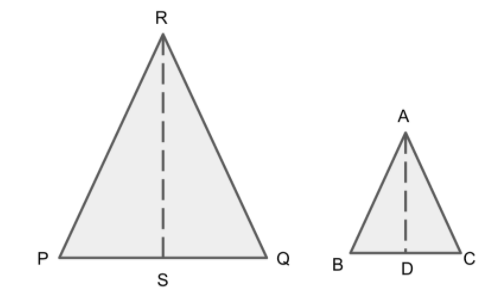
The ratio of the areas of two similar triangles is equal to the square of the ratio of their corresponding sides.
Answer
574.8k+ views
Hint:
First, we will calculate the area of two similar triangles and then divide them. Then the similarities of two triangles are used to find the ratios of the corresponding sides.
Complete step by step solution:
Let us assume the two triangles are \[\Delta {\text{PQR}}\] and \[\Delta {\text{ABC}}\].

We will use the formula to find the area of triangle, \[{\text{Area = }}\dfrac{1}{2} \times {\text{Base}} \times {\text{Height}}\].
Now, we will find the area of the triangles \[\Delta {\text{ABC}}\] and \[\Delta {\text{PQR}}\] from the above diagram.
\[{\text{Area of }}\Delta {\text{PQR}} = \dfrac{1}{2} \times {\text{QR}} \times {\text{PS ......}}\left( 1 \right)\]
\[{\text{Area of }}\Delta {\text{ABC}} = \dfrac{1}{2} \times {\text{BC}} \times {\text{AD ......}}\left( 2 \right)\]
Dividing \[\left( 1 \right)\] by \[\left( 2 \right)\], we get
\[
\dfrac{{{\text{Area of }}\Delta {\text{PQR}}}}{{{\text{Area of }}\Delta {\text{ABC}}}} = \dfrac{{\dfrac{1}{2} \times {\text{QR}} \times {\text{PS}}}}{{\dfrac{1}{2} \times {\text{BC}} \times {\text{AD}}}} \\
= \dfrac{{{\text{QR}} \times {\text{PS}}}}{{{\text{BC}} \times {\text{AD}}}}{\text{ ......}}\left( 3 \right) \\
\]
Since we know that \[\angle {\text{ABC}}\] and \[\angle {\text{PQR}}\] are angles of similar triangles, so \[\angle {\text{ABC}} = \angle {\text{PQR}}\] and both right angled triangles \[\angle {\text{ADB}}\] and \[\angle {\text{PSQ}}\] are equal.
Therefore, \[\Delta {\text{PQS}} \sim \Delta {\text{ABD}}\].
\[ \Rightarrow \dfrac{{{\text{PS}}}}{{{\text{AD}}}} = \dfrac{{{\text{PQ}}}}{{{\text{AB}}}}{\text{ ......}}\left( 4 \right)\]
Substituting this value in equation \[\left( 3 \right)\], we get
\[\dfrac{{{\text{Area of }}\Delta {\text{PQR}}}}{{{\text{Area of }}\Delta {\text{ABC}}}} = \dfrac{{{\text{QR}}}}{{{\text{BC}}}} \times \dfrac{{{\text{PQ}}}}{{{\text{AB}}}}{\text{ ......}}\left( 5 \right)\]
Since we know that the triangles \[\Delta {\text{PQR}}\] and \[\Delta {\text{ABC}}\] are similar,
\[\dfrac{{{\text{PQ}}}}{{{\text{AB}}}} = \dfrac{{{\text{QR}}}}{{{\text{BC}}}} = \dfrac{{{\text{PR}}}}{{{\text{AC}}}}\]
Using this value in equation \[\left( 5 \right)\], we get
\[
\dfrac{{{\text{Area of }}\Delta {\text{PQR}}}}{{{\text{Area of }}\Delta {\text{ABC}}}} = \dfrac{{{\text{QR}}}}{{{\text{BC}}}} \times \dfrac{{{\text{QR}}}}{{{\text{BC}}}} \\
= {\left( {\dfrac{{{\text{QR}}}}{{{\text{BC}}}}} \right)^2} \\
\]
Also from equation \[\left( 5 \right)\], we get
\[
\dfrac{{{\text{Area of }}\Delta {\text{PQR}}}}{{{\text{Area of }}\Delta {\text{ABC}}}} = {\left( {\dfrac{{{\text{QR}}}}{{{\text{BC}}}}} \right)^2} \\
= {\left( {\dfrac{{{\text{PQ}}}}{{{\text{AB}}}}} \right)^2} \\
= {\left( {\dfrac{{{\text{RP}}}}{{{\text{CA}}}}} \right)^2} \\
\]
Thus, the ratio of the areas of two similar triangles is equal to the square of the ratio of their corresponding sides.
Hence, proved.
Note:
In this question, students should write the sides of the triangles appropriately. Since the general area of any triangle is \[{\text{Area = }}\dfrac{1}{2} \times {\text{Base}} \times {\text{Height}}\], so we need to construct the perpendicular triangles for height. Students should know that when two triangles are similar then the ratio of their corresponding sides are same with the ratio of their corresponding altitudes and sides. The measurement of their corresponding angles is also the same.
First, we will calculate the area of two similar triangles and then divide them. Then the similarities of two triangles are used to find the ratios of the corresponding sides.
Complete step by step solution:
Let us assume the two triangles are \[\Delta {\text{PQR}}\] and \[\Delta {\text{ABC}}\].

We will use the formula to find the area of triangle, \[{\text{Area = }}\dfrac{1}{2} \times {\text{Base}} \times {\text{Height}}\].
Now, we will find the area of the triangles \[\Delta {\text{ABC}}\] and \[\Delta {\text{PQR}}\] from the above diagram.
\[{\text{Area of }}\Delta {\text{PQR}} = \dfrac{1}{2} \times {\text{QR}} \times {\text{PS ......}}\left( 1 \right)\]
\[{\text{Area of }}\Delta {\text{ABC}} = \dfrac{1}{2} \times {\text{BC}} \times {\text{AD ......}}\left( 2 \right)\]
Dividing \[\left( 1 \right)\] by \[\left( 2 \right)\], we get
\[
\dfrac{{{\text{Area of }}\Delta {\text{PQR}}}}{{{\text{Area of }}\Delta {\text{ABC}}}} = \dfrac{{\dfrac{1}{2} \times {\text{QR}} \times {\text{PS}}}}{{\dfrac{1}{2} \times {\text{BC}} \times {\text{AD}}}} \\
= \dfrac{{{\text{QR}} \times {\text{PS}}}}{{{\text{BC}} \times {\text{AD}}}}{\text{ ......}}\left( 3 \right) \\
\]
Since we know that \[\angle {\text{ABC}}\] and \[\angle {\text{PQR}}\] are angles of similar triangles, so \[\angle {\text{ABC}} = \angle {\text{PQR}}\] and both right angled triangles \[\angle {\text{ADB}}\] and \[\angle {\text{PSQ}}\] are equal.
Therefore, \[\Delta {\text{PQS}} \sim \Delta {\text{ABD}}\].
\[ \Rightarrow \dfrac{{{\text{PS}}}}{{{\text{AD}}}} = \dfrac{{{\text{PQ}}}}{{{\text{AB}}}}{\text{ ......}}\left( 4 \right)\]
Substituting this value in equation \[\left( 3 \right)\], we get
\[\dfrac{{{\text{Area of }}\Delta {\text{PQR}}}}{{{\text{Area of }}\Delta {\text{ABC}}}} = \dfrac{{{\text{QR}}}}{{{\text{BC}}}} \times \dfrac{{{\text{PQ}}}}{{{\text{AB}}}}{\text{ ......}}\left( 5 \right)\]
Since we know that the triangles \[\Delta {\text{PQR}}\] and \[\Delta {\text{ABC}}\] are similar,
\[\dfrac{{{\text{PQ}}}}{{{\text{AB}}}} = \dfrac{{{\text{QR}}}}{{{\text{BC}}}} = \dfrac{{{\text{PR}}}}{{{\text{AC}}}}\]
Using this value in equation \[\left( 5 \right)\], we get
\[
\dfrac{{{\text{Area of }}\Delta {\text{PQR}}}}{{{\text{Area of }}\Delta {\text{ABC}}}} = \dfrac{{{\text{QR}}}}{{{\text{BC}}}} \times \dfrac{{{\text{QR}}}}{{{\text{BC}}}} \\
= {\left( {\dfrac{{{\text{QR}}}}{{{\text{BC}}}}} \right)^2} \\
\]
Also from equation \[\left( 5 \right)\], we get
\[
\dfrac{{{\text{Area of }}\Delta {\text{PQR}}}}{{{\text{Area of }}\Delta {\text{ABC}}}} = {\left( {\dfrac{{{\text{QR}}}}{{{\text{BC}}}}} \right)^2} \\
= {\left( {\dfrac{{{\text{PQ}}}}{{{\text{AB}}}}} \right)^2} \\
= {\left( {\dfrac{{{\text{RP}}}}{{{\text{CA}}}}} \right)^2} \\
\]
Thus, the ratio of the areas of two similar triangles is equal to the square of the ratio of their corresponding sides.
Hence, proved.
Note:
In this question, students should write the sides of the triangles appropriately. Since the general area of any triangle is \[{\text{Area = }}\dfrac{1}{2} \times {\text{Base}} \times {\text{Height}}\], so we need to construct the perpendicular triangles for height. Students should know that when two triangles are similar then the ratio of their corresponding sides are same with the ratio of their corresponding altitudes and sides. The measurement of their corresponding angles is also the same.
Recently Updated Pages
Two men on either side of the cliff 90m height observe class 10 maths CBSE

What happens to glucose which enters nephron along class 10 biology CBSE

Cutting of the Chinese melon means A The business and class 10 social science CBSE

Write a dialogue with at least ten utterances between class 10 english CBSE

Show an aquatic food chain using the following organisms class 10 biology CBSE

A circle is inscribed in an equilateral triangle and class 10 maths CBSE

Trending doubts
Why is there a time difference of about 5 hours between class 10 social science CBSE

Write a letter to the principal requesting him to grant class 10 english CBSE

What is the median of the first 10 natural numbers class 10 maths CBSE

The Equation xxx + 2 is Satisfied when x is Equal to Class 10 Maths

Which of the following does not have a fundamental class 10 physics CBSE

State and prove converse of BPT Basic Proportionality class 10 maths CBSE




